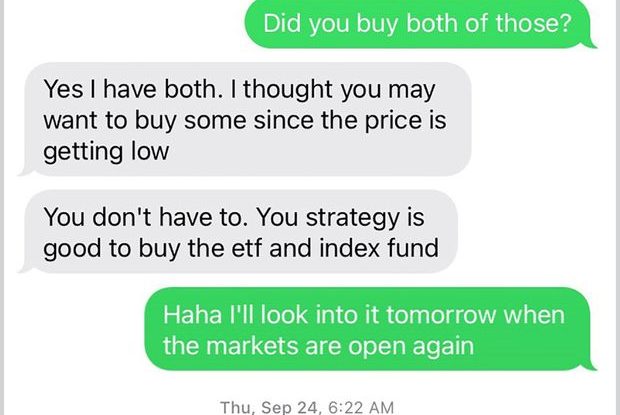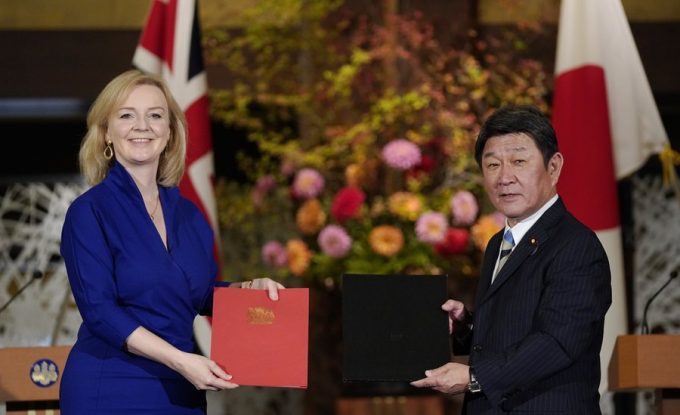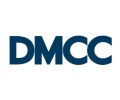President Donald Trump on Friday lobbed Twitter attacks at China, U.S. companies and his handpicked Federal Reserve chief as he further escalated his tariff battle with the world’s No. 2 economy — a reflection of Trump’s rising anxiety about an increasingly troubled economic picture at home.
Trump responded with fury after taking a pair of blows Friday morning when China announced a fresh round of tariffs and Fed Chairman Jay Powell did not explicitly pledge aggressive interest rate cuts as the president demanded.
Story Continued Below
Erupting on Twitter, the president denounced China’s retaliatory tariffs as “politically motivated,” after earlier ordering U.S. companies to find an alternative to doing business with China and suggesting Powell could be a “bigger enemy” than China’s communist leader.
Trump on Friday evening struck back at China by saying he would hike already existing tariffs on $250 billion in Chinese imports from 25 percent to 30 percent starting Oct. 1. In addition, tariffs on $300 billion worth of other goods would increase from 10 percent to 15 percent as originally planned starting on Sept. 1.
Trump said in announcing the tariff hikes that he’d done so because “in the spirit of achieving Fair Trade, we must Balance this very unfair Trading Relationship” with China, which he said had become a “great burden” to taxpayers.
It was unclear exactly what Trump meant with his directive to the U.S. companies or whether he plans additional action to execute the order, but the tweets captured the president’s frustration as his escalating trade war with China weighs on the economy and heightens the risk of a recession during an election year.
“Our Country has lost, stupidly, Trillions of Dollars with China over many years. They have stolen our Intellectual Property at a rate of Hundreds of Billions of Dollars a year, & they want to continue,” Trump wrote. “I won’t let that happen! We don’t need China and, frankly, would be far better off without them.”
He continued, “The vast amounts of money made and stolen by China from the United States, year after year, for decades, will and must STOP. Our great American companies are hereby ordered to immediately start looking for an alternative to China, including bringing your companies HOME and making your products in the USA. I will be responding to China’s Tariffs this afternoon. This is a GREAT opportunity for the United States.”
Investors had been in a relatively forgiving mood after China‘s tariffs and the Fed speech on Friday. But Trump’s tweets triggered a sharp sell-off in the stock market, with the Dow Jones Industrial Average down more than 600 points and the S&P 500 tumbling about 2.6 percent by the end of trading. The president’s own tariff escalation came an hour after regular trading closed for the week.
Trump’s initial tweets took the president’s aides by surprise, triggering the latest instance of the White House making policy on the fly after Trump issued a directive via Twitter. Trump huddled midday with his economic team including trade adviser Peter Navarro, U.S. Trade Representative Robert Lighthizer, National Economic Council Director Larry Kudlow and Treasury Secretary Steven Mnuchin, who was on vacation and called into the meeting by phone, according to a senior administration official.
The president seems unlikely to back away from the trade stand-off with China anytime soon, close White House allies and current and former administration officials said.
During a two-hour meeting in the Oval Office on Monday with several top aides and Cabinet members, Trump repeatedly told attendees “I just want a fair deal” when it comes to China. The meeting included discussion of both China and trade, among other topics, ahead of this weekend’s G7 summit.
“The president is optimistic and confident that the U.S. has the benefit and the upper hand with China,” insisted one former senior administration official. “I do not think he will back down.”
Current and former White House aides viewed China’s retaliatory tariffs on Friday — and Trump’s Twitter response to them — as both countries angling for dominance ahead of the G7.
China earlier Friday announced a fresh round of tariffs on $75 billion in U.S. goods ranging from 5 percent to 10 percent. They will go into effect in waves beginning Sept. 1 and Dec. 15, Beijing said.
China’s state-run news agency Xinhua on Friday quoted the country’s tariff commission, which said the penalties were in response to levies threatened by the U.S. on $300 billion worth of Chinese goods.
“The U.S. measures have led to the continuous escalation of China-U.S. economic and trade frictions, which have greatly harmed the interests of China, the U.S. and other countries, and have also seriously threatened the multilateral trading system and the principle of free trade,” Beijing said.
The announcement from China came just before a speech from Powell in which he said the central bank stands ready to do what is necessary to support the record-long U.S. economic expansion. But he did not signal that significant interest rate cuts will be coming soon, angering Trump.
“As usual, the Fed did NOTHING! It is incredible that they can ‘speak’ without knowing or asking what I am doing, which will be announced shortly. We have a very strong dollar and a very weak Fed. I will work ‘brilliantly’ with both, and the U.S. will do great,” Trump tweeted.
He then launched a personal attack on Powell, writing, “My only question is, who is our bigger enemy, Jay Powell or Chairman Xi?”
Among the other options Trump was weighing for hitting back against Beijing was reversing a special waiver granted this week that gave U.S. companies three more months to conduct a limited amount of business with blacklisted Chinese telecommunications giant Huawei, said a person close to the deliberations. The president made no mention of taking action with regard to Huawei in his Friday evening tweets.
Trump’s outrage at China’s retaliation was largely driven by his perception that the Chinese economy is on the brink of ruin and Beijing would be reluctant to make a move that would further put it in jeopardy, the person said.
“It was a great surprise to Trump,” the person said of China’s announcement that it would retaliate.
Trump has repeatedly claimed in recent days that U.S. tariffs were causing China to hemorrhage jobs, up to 2.5 million “in a very short period of time,” and has cited other numbers.
“They had the worst year in 27 years, but I think it was actually 52 or 54 years. It was the worst year they’ve had in a half a century. And that’s because of me,” Trump told reporters Wednesday.
The person close to the talks said Trump’s view has been largely informed by Navarro, who has advocated a complete decoupling between the U.S. and Chinese economies. Trump on Friday echoed that sentiment by telling U.S. companies to leave China.
Other aides have cautioned Trump not to discount China’s ability to weather economic pain and its willingness to retaliate against the additional tariffs he announced on Aug. 1, the person said.
Trump’s tariff escalation will leave U.S. companies even more uncertain about purchasing, investments and day-to-day business, business groups said.
“It’s impossible for businesses to plan for the future in this type of environment,” said David French, the National Retail Federation’s senior vice president for government relations. “Where does this end?”
The Retail Industry Leaders Association warned Trump to end the trade war before any damage becomes irreversible. “If uncertainty spreads from Wall Street to Main Street, the record expansion we’re enjoying will undoubtedly come to an end and it will be the American consumer, not China, who will suffer,” said Brian Dodge, the group’s chief operating officer.
The tariff escalation to 30 percent will increase import costs for a list that includes hundreds of intermediate goods, such as machinery and chemicals, used by U.S. manufacturers. Goods that will see a 15 percent tariff — an increase from the initial 10 percent rate — include a wide array of consumer goods including clothes, smartphones, computers and other electronics.
The latest move by Trump could make a possible deal between the U.S. and China even more remote.
“It’s very difficult to step back from the brink once you’ve gone this far, but you’re not going to get a deal under these circumstances,” said Rufus Yerxa, president of the National Foreign Trade Council.
“So your choices are either you step backwards and admit failure, or you keep charging ahead further into more danger,” he added. “Unfortunately, he seems to be heading forward into more danger.”
American farmers have felt the brunt of the trade war for the last year and the latest escalation has them bracing for more pain.
“Real people — Chinese citizens, the American public, and our soybean farmers — are the ones feeling the effects of this trade war,” said Davie Stephens, a soybean farmer from Clinton, Ky., who serves as president of the American Soybean Association.
Stephens also lamented that the escalation of tariffs will mean tough conditions will persist for a long time. “The longevity of this situation means worsening circumstances for soy growers who still have unsold product from this past season and new crops in the ground this season — with prospects narrowing even more now for sales with China,” he said.
The Trump administration has increasingly cited the need to realign U.S. agriculture away from China. But that’s a tall order given the sheer size of the country, its increasing demand for protein and the many years U.S. producers spent in cultivating the market.
Pork exporters are particularly feeling frustrated by the fact that they cannot take advantage of the lucrative Chinese market. Imports from the United States already face 62 percent duties and will soon have 10 percent more added. (Still, 2019 so far has been better for the pork industry than last year because African swine fever has devastated pig herds in China, forcing China to import more.)
“U.S. pork producers are eager to compete on a level playing field in China and to more fully participate in this unprecedented opportunity,” the National Pork Producers Council said in a statement. “Unfortunately, the current trade dispute prevents us from doing so.”
Meanwhile, U.S. companies in China say they aren’t going anywhere despite Trump’s latest Twitter order and the ongoing challenges of operating in that market.
“China will contribute a significant proportion of global growth in the decades ahead,” said Jake Parker, senior vice president of the U.S.-China Business Council. “Missing out on that opportunity would weaken the competitiveness of U.S. industry and harm the United States national interests at home.”
The U.S. Chamber of Commerce, the leading lobbying group for U.S. businesses, sought to lower the temperature. “U.S. companies have been ambassadors for positive changes to the Chinese economy that continue to benefit both our people,“ said Myron Brilliant, the Chamber’s executive vice president and head of international affairs. “We do not want to see a further deterioration of U.S.-China relations. We urge the administration and the government of China to return to the negotiating table.“
Earlier on Friday, Navarro, who provides a strong protectionist voice on U.S. trade talks within the Trump administration, denied that China’s announcement caught the White House off guard and downplayed the impact of the move.
“This was a move that was well-signaled,” Navarro said on CNN. “It’s breaking news, I guess, but it was well-anticipated.”
The latest front in the tariff battle between China and the U.S. comes as fears grow about a recession. Trump has tweeted relentlessly about the issue in recent days, pinning blame on Powell while he heralded what he says is a booming economy that he’s accused the news media of trying to tank to hurt his reelection prospects.
Though he conceded the economy was slowing, Navarro blamed the Fed for slow-walking rate cuts, calling economic worries “a pure Federal Reserve effect on higher interest rates.”
Navarro was pressed on some business leaders’ admissions that the uncertainty due to the trade war was dampening investment, but he again blamed monetary policy emanating from the Fed.
“They can’t make investments because the Fed raised interest rates too far, too fast,” he argued. “If you raise interest rates, you cut down investment and you cut down exports.”
But business groups contradicted Navarro, expressing a clear annoyance with the constant threats.
“It’s impossible for businesses to plan for the future in this type of environment,” said David French, senior vice president of the National Retail Federation, after Trump announced his retaliation. “The administration’s approach clearly isn’t working, and the answer isn’t more taxes on American businesses and consumers. Where does this end?”
Ahead of Powell’s speech, both Navarro and Trump appeared confident in what the Fed chief would say, sentiments that apparently evaporated immediately after the Fed chairman’s remarks at a Kansas City Fed conference in Jackson Hole, Wyo.
“Now the Fed can show their stuff!” Trump said about an hour before the speech.
Navarro also talked up Powell’s remarks, framing them as a potential counterweight to the tariff news.
“What’s important today — look, this is a big day, tomorrow is a big day. It’s a big day today because we’re going to get better signals from the federal reserve as to whether they’re going to get in line with over 30 central banks around the world that have been cutting rates,” he said, adding later that forecasting aggressive rate cuts should show “he’s got America’s back.”
The central bank and Powell have become favorite punching bags of Trump as ominous economic signs have emerged ahead of next year’s election. But Navarro, unprompted at the top of the CNN interview, said there’s “no anxiety in the White House about the economy.”
“We don’t run around the West Wing with anxiety. We look at the chessboard and we see basically a strong Trump economy growing at 2 percent because of tax cuts, deregulation, cheap energy and trade,” he said.
While China‘s latest latest retaliatory tariffs seem to have especially provoked Trump’s fury, they represent “a mild, proportionate response,” to the U.S. decision earlier this month to move forward with more duties, said Agathe Demarais, global forecasting director at The Economist Intelligence unit.
“The recent rise in nationalist, patriotic behavior in China means that it would have been impossible for the Chinese government not to react to the latest U.S. tariffs,” she said.
In the grand scheme of things, tariffs of 5 percent to 10 percent on $75 billion worth of imports “is not even a rounding error in estimating the impact on the U.S. economy,” added Derek Scissors, a China expert at the American Enterprise Institute who has advised the Trump administration.
But the move is more of a “token action” that signals that Beijing doesn’t see ongoing trade talks between the two countries going anywhere, he said.
The two sides have for more than a year been engaged in talks discussing systemic issues like China’s handling of U.S. intellectual property and other market access and trade issues, including its purchases of American farm goods.
In his later tweets, Trump also singled out shipping companies, writing, “Also, I am ordering all carriers, including Fed Ex, Amazon, UPS and the Post Office, to SEARCH FOR & REFUSE, all deliveries of Fentanyl from China (or anywhere else!). Fentanyl kills 100,000 Americans a year. President Xi said this would stop – it didn’t. Our Economy, because of our gains in the last 2 1/2 years, is MUCH larger than that of China. We will keep it that way!”
Trump and his aides have been mostly unyielding in his complaints that Powell and the Fed are to blame for any economic sluggishness, but Powell on Friday singled out the erratic trade directives coming from the White House.
Powell vowed that the central bank will “act as appropriate” to sustain a record-breaking, decade-long stretch of economic growth following the 2008 financial crisis. But he steered away from providing specifics, calling uncertainty stemming from Trump’s trade policies one of the major factors he was keeping an eye on.
He also cited other geopolitical events like the growing possibility of a hard Brexit, rising tensions in Hong Kong and the dissolution of the Italian government, saying “long term bond rates around the world have moved down sharply to near post-crisis lows.“
But the Fed chief emphasized the novelty of the current trade environment, telling the audience that “fitting trade policy uncertainty into this framework is a new challenge. There are … no recent precedents to guide any policy response to the current situation.”
He continued, “while monetary policy is a powerful tool that works to support consumer spending, business investment and public confidence, it cannot provide a settled rulebook for international trade. We can, however, try to look through what may be passing events, focus on how trade developments are affecting the outlook, and adjust policy to promote our objectives.”
Megan Cassella, Liz Crampton and Ryan McCrimmon contributed to this report.
This article tagged under:
Missing out on the latest scoops? Sign up for POLITICO Playbook and get the latest news, every morning — in your inbox.





